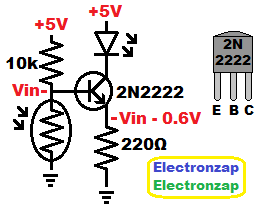Table of Contents
Light Dependent Resistor (LDR) and NPN Bipolar Junction Transistor (BJT) current source determines how much current flows through the LED load. Less light falling on LDR, leads to more LED current. That causes the LED to produce more light.

- Voltage across emitter resistor is approx. 0.6V less than whatever the voltage at the Base is.
- The LDR (light dependent resistor) is on the low side of a voltage divider in this circuit. Low side means that it is closer to 0V ground.
- More light falling on LDR lowers it resistance, causing a more better connection between the Base and ground. Therefore it causes the the voltage divider output voltage to go down.
- Less light falling on LDR increases it’s resistance, making the connection to ground worse. Therefore it causes the voltage divider output (base input) voltage to rise.
- There must be enough total (supply) voltage to power the emitter resistor, transistor collector to emitter, and the load.
- White, blue, or green LED load will drop about 3V of the 5V supply from the emitter resistor. That means that the emitter resistor will only be able to build up about 2V across it. There will be no difference in the amount of current that flows after the NPN BJT Base voltage rises to above 2.6V.
- Red, orange, or yellow LED load will drop about 2V of the 5V power supply from the emitter resistor. That means that the emitter resistor will only be able to build up about 3V across it. No extra current will flow once the NPN BJT Base voltage rises above approx. 3.6V.
- The current through the resistor can be calculated with Ohms law formula for current. Which is I=V/R. The current (in amps) through the resistor is the voltage (in volts) across it, divided by it’s resistance in ohms. That is also the current that will flow through an LED load, or any other load that doesn’t drop/divide away too much voltage.
- 1V/220Ω = 0.004545A (4.5mA)
- 2V/220Ω = 0.009A (9mA)
- 3V/220Ω = 0.013636A (13.6mA)
Video:
To support this site, check out the following links:
Art of electronics is easily my favorite learning electronics book. It helps to already be familiar with basic electronics while studying it. It inspires many of my demonstration circuits. An affiliate link ad that supports this site.
- Become a Patron!
- Check out my YouTube videos! https://www.youtube.com/c/Electronzap/videos
- Products I used in my videos or otherwise think look like a good buy. As an Amazon associate, I earn from qualifying purchases. https://www.amazon.com/shop/electronzapdotcom
- Information on this site is not guaranteed to be accurate. Always consult the manufacturer info/datasheet of parts you use. Research the proper safety precautions for everything you do.
- Electronzap is a participant in the Amazon Services LLC Associates Program, an affiliate advertising program designed to provide a means for sites to earn advertising fees by advertising and linking to amazon.com.